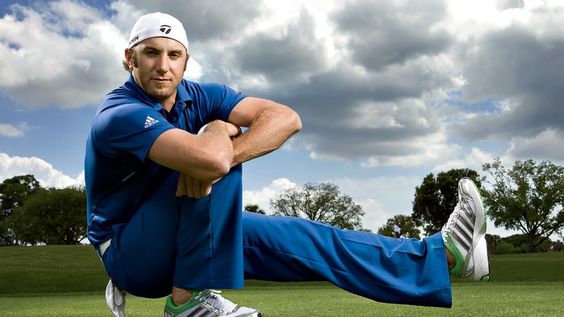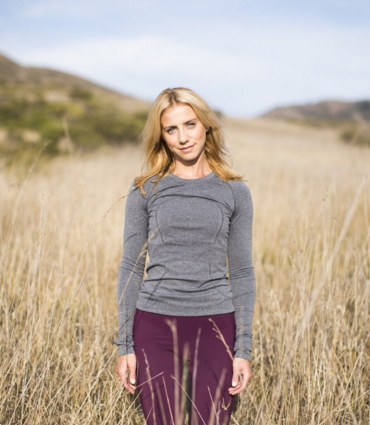IMPROVE MY GAME
Articles
Four Exercises for Stronger, More Powerful Glutes
Mon Feb 15, 2016 by Dr. Ben Langdown and Jennifer Fleischer

By Dr. Ben Langdown (@BenLangdown) and Jennifer Fleischer (@HolisticFitSF).
Whether you’re looking to improve your golf game, speed up your sprints or simply prevent injuries and low back pain, focusing on glute strength is one of the most important things you can do in the gym. In this blog, Ben Langdown (@benlangdown) Sports Scientist, Golf Strength & Conditioning Coach and Ph.D in the field of Golf Biomechanics and Swing Variability, shares four exercises he uses with his athletes for increasing glute strength, ranging from beginner to more challenging. In our previous blog (hosted at HolisticFitSF.com), Ben discussed the negative effects of desk posture and how it can cause a tight low back and hip flexors as well as weak abdominals and glutes. In this blog, we are going to focus on what exactly the glutes do, what happens when they are weak, and what you can do to get them working for you again! While there’s no substitute for going to see a strength and conditioning coach to get an individualized program, we hope this blog will teach you how to start training for stronger glutes in your next workout. I hope you find it useful!
If you are keen on progressing your training in the gym to higher loads or intensities while remaining injury-free, then it’s imperative that your glutes are effective in their roles. Let’s start by having a brief look at the role of each of the gluteals and how limitations in their strength can affect your daily life and your golf performance! The gluteals are made up of three different muscles which, although they sound like they have been named on their success as Roman gladiators, are actually named based on their size: Gluteus Maximus, Medius and Minimus. Each has a different role to play within the movements we make:
Maximus: The gluteus maximus, as its name suggests, is the largest of the gluteal muscles and acts as a powerful hip extensor(1). It helps maintain balance when you walk, provides control of your torso when you run, and is activated to drive you back up when you get to the bottom of a deep squat (i.e. where the thigh breaks parallel with the floor). The gluteals also play a vital role in golf performance(2) and it has been suggested previously that the gluteus maximus contributes significantly to hip stabilisation during the swing(2,3).
Strength in the gluteus maximus can also allow posture to be maintained during the swing(4), power to be created during the downswing and the triple extension movement to occur through impact which can result in greater clubhead speed. This has been shown in previous electromyography (EMG) research studies(5) where it has been identified that in right-handed golfers the right gluteus maximus is highly active during the beginning of the downswing and the acceleration phase towards impact.
Medius: The gluteus medius provides internal hip rotation (inwards), hip abduction (moving the leg out to the side) and stabilisation of the hip. When you walk, for example, your gluteus medius muscle allows your standing leg’s hip to be stabilised, which keeps your pelvis level and prevents your opposite hip from dropping. Severe cases of weakness here can result in the “Trendelenburg gait” which is an abnormal walking coordination pattern where the opposite hip to the standing leg drops due to underactive hip abductors (i.e. the gluteus medius and minimus) and the upper body moves to compensate through each stride.
Ok, so we know weak gluteus medius can affect our stride, but how does it affect our golf swing? Again the gluteus medius plays a large role in preventing excessive lateral sway and slide of the pelvis into the backswing and downswing respectively. If the gluteus medius is conducting its role effectively then it will aid internal rotation into the trail hip in the backswing and the lead hip in the downswing. It has also been suggested that the glute medius is active on the trail side during the acceleration phase of the downswing (i.e. where the club is moving from half way down to impact with the golf ball)(2).
However, if the gluteus medius becomes under-active, the TFL can become overactive which can lead to knee pain, hip pain, and unwanted movements of the knee joint.
Minimus: Although it’s the smallest of the gluteals, the glute minimus has important functions to perform including being a primary internal hip rotator and also helps with abduction of the leg, and hip extension. Along with the gluteus medius, the minimus is also responsible for stabilising the hip of the standing leg when walking.
Now that we’ve gone over the gluteals and their functions, let’s look a bit closer at what can happen to golfers when their glutes are lazy! A research study on 56 golfers found a substantial difference in the glute strength between lower handicap golfers (high skilled) and high handicap golfers (lesser skilled)(6). The study determined that golfers with a lower handicap were more likely to have increased pelvis rotation speed (503 d/s) compared to higher handicap players (380 d/s). Potentially this difference is due to their increased skill level and more effective motor patterns rather than, or alongside, physiological variations, which can be a major limitation of different skill group comparisons. The authors of this research came to the conclusion that this disparity was the result of increased gluteal strength in the low handicap golfers, specifically the strength of the gluteus maximus and medius.
Low handicap group:
Mean strength for right and left gluteus maximus = 30.5% and 30.6% of body weight respectively.
High handicap group:
Mean strength for right and left gluteus maximus = 21.9% and 20.7% respectively.
Similar results were reported for the gluteus medius. This research doesn’t explain everything but it suggests that strengthening the glutes can be a contributing factor to improving your golf swing and reducing that all-important handicap level. Another researcher has also suggested that clubhead speed could be influenced by the strength of the gluteals (and other lower body muscles)(7), which should further motivate you to get in the gym and ensure that at least some of your training programme targets this area of your body!
Right, enough with all the talking -- you want to know how to strengthen the glutes! Below are four exercises that I use with my athletes to engage the glutes and build strength in these important muscles. There are four single leg exercises and one is the basic squat movement using body weight or a dumbbell to get you started if you’ve not done much glute work before. As mentioned above, you should see an expert trainer for an individualized program if you are serious about taking your training to the next level.
This is the first squat progression I use with my athletes (using both legs) to improve their movement patterns. A body weight squat is a great exercise to begin with and then you can add weight to complete the goblet squat. Often the weight provides a bit of counter-weight that helps people drop lower into the squat without falling backwards or tilting the torso forwards. Researchers have suggested that the best exercise to activate the gluteus maximus is the full squat(8). In order to fully activate the gluteus maximus you need to break parallel with the thigh in relation to the floor. Don’t lose form as you go to this depth. So, keep the pelvis in a neutral posture and avoid tucking it under (posterior tilt) and curving the lower back. On the other hand, avoid sticking the butt out and excessively arching the lower back as again this can place too much pressure on this area.
Feet around shoulder width apart, toes can be turned out to around 5 to 1 / 10 to 2 on a clock face (turning them out can allow increased depth for those with restricted range of movement).
Set the shoulders and brace the trunk before you begin the descent and take a breath in and hold until the end of the upward phase of the squat.
Begin the descent by flexing at the hips and knees simultaneously. Then descend into the squat moving your weight from mid-foot to the heels at the bottom position. The bottom position should be where the thighs have broken parallel with the floor.
Drive back up from the bottom position leading with the chest and using the glutes to fire back up to standing.
Repeat for 3-4 sets of 4-6 reps
Single Leg Squats:
There are two progressions to this exercise. The first (easier exercise) is to use a gym ball against a wall. Place the standing foot under the hip and lean onto the ball with your hip. Lift the inside leg up to around 90 degrees and then squat down as low as you can. Use the ball to support you and ensure your squatting leg does not collapse inwards at the knee. The knee should track over the toes as you squat. If you can’t feel the glutes working try tucking the pelvis under slightly just before you start the squat each time. The ball is there to help you so make sure you lean into it while keeping that standing leg under the hip. Repeat for 3 sets of 4 reps to begin.
Once you are comfortable with this exercise try moving on to a single leg squat to box using a mini-band to further activate the glutes. Place a mini-band just above the knees, pull the free leg up and out to the side to put tension on the band. You should feel the glutes activated when you do this. Then putting your arms out in front of you to help control your descent, squat down through the standing leg towards the box / bench. Try to lightly sit on the box / bench and then drive back up again. If you can’t get to this point you could always add a pad onto the box in order to reduce the depth that you need to squat to begin with. Try to increase the depth you squat every week until you can get to the box. Control the squat – don’t just sit down! Repeat for 3 sets of 4 reps to begin.
Here's Ian Poulter doing single leg exercises from a box:
Comfortable doing these? Challenge yourself – can you do a pistol squat?! If you can, congratulate yourself, I don’t come across many people that can do this.

Ok, enough showing off…on to the final two ideas for you to try in the gym which will incorporate some rotation and upper body work…
Supported Single Leg Deadlifts with Rotation:
A great little exercise that requires rotation and stability as you are standing on one leg throughout. Place one foot against the wall and ensure the front foot is far enough forwards that when you complete the exercise you can feel the glutes being worked! Ensure that you rotate towards the front leg and turn your entire torso (instead of just swinging your arms). Squat low enough to touch the inside of your foot and don’t try to reach with your hand. Try completing 2-3 sets of 6 reps each side to begin with. If you are struggling with balance, place the back foot on the floor and then progress up to the wall.
Single Leg Deadlift with Dumbbell Row:
The final exercise for this blog is another single leg drill. Weight doesn’t need to be used to begin with if you struggle with the deadlift part. Try to keep the knee at the same angle throughout this exercise (straight leg but unlocked knee). Hinge at the hips and keep the torso (spine angle) tight / braced throughout. This exercise requires stability through the standing leg and requires work from the glutes in both the standing leg and the free leg as it lifts into the end of the downward phase. At this point you can add in some upper body work through additional movements such as the row (demonstrated in this video) or reverse fly type exercises. Again try completing 2-3 sets of 6 reps each side to begin with and add additional load when you are comfortable with this exercise.
Here's Lee Westwood performing an RDL (without the row):

Dr. Ben Langdown is the Training Executive for Sports Science at the PGA National Training Academy at the Belfry. Alongside this Ben also works with many elite amateur and professional golfers providing strength and conditioning support. Ben has a PhD in the field of golf biomechanics, studying strength and conditioning for golf and movement variability in the swing. Follow Ben at @BenLangdown.

Jennifer Fleischer is the founder of Holistic Fitness San Francisco, a wellness consulting company that offers Golf Fitness Training, Strength and Conditioning Programs and Integrative Nutrition Coaching. She is a Level 3 Titleist Performance Institute Certified Golf Fitness Instructor. Follow Jennifer at @HolisticFitSF.
References:
1. Kang, S.Y., Jeon, H.S., Kwon, O., Cynn, H.S., & Choi, B. (2013). Activation of the gluteus maximus and hamstring muscles during prone hip extension with knee flexion in three hip abduction positions. Manual therapy, 18(4), 303-307.
2. McHardy, A. & Pollard, H. (2005). Muscle activity during the golf swing. British Journal of Sports Medicine, 39(11), 799–804.
doi: 10.1136/bjsm.2005.020271
3. Watkins, R.G., Uppal, G.S., Perry, J., Pink, M., & Dinsay, J.M. (1996). Dynamic electromyographic analysis of trunk musculature in professional golfers. The American journal of sports medicine, 24(4), 535-538.
4. Phillips, D. (2013, March). Early Extension Swing Characteristic. TPI Improve My Game Articles. Retrieved from: http://www.mytpi.com/articles/swing/early_extension_swing_characteristic
5. Okuda, I., Armstrong, C.W., Tsunezumi, H. & Yoshiike, H. (2002). Biomechanical analysis of a professional golfer’s swing: A case study of Hidemichi Tanaka. In E. Thain (Ed.), Science and Golf IV: Proceedings of the World Scientific Congress of Golf (pp. 8-16). London: Routledge.
6. Callaway, S., Glaws, K., Mitchell, M., Scerbo, H., Voight, M., & Sells, P. (2012). An analysis of peak pelvis rotation speed, gluteus maximus and medius strength in high versus low handicap golfers during the golf swing. International Journal of Sports Physical Therapy, 7(3), 288–295.
7. Hellström, J. (2008). The Relation Between Physical Tests, Measures, and Clubhead Speed in Elite Golfers. International Journal of Sports Science & Coaching, 3, 85–92. doi:10.1260/174795408785024207
8. Wilson, J., Ferris, E., Heckler, A., Maitland, L., Taylor, C. (2004). A structured review of the role of gluteus maximus in rehabilitation. New Zealand Journal of Physiotherapy, 33(3), 95-100.